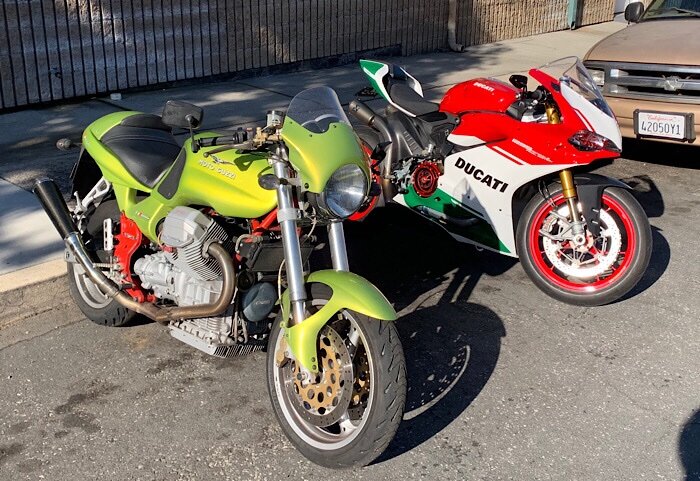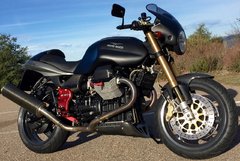Leaderboard
Popular Content
Showing content with the highest reputation on 08/08/2021 in all areas
-
5 points
-
This might be of interest to some here. I have heard reports of people being asked to pay outrageous money to have the tappets inspected on their early 8V motors. I made this vid several years ago but it recently got taken down off YouTube for a 'Copyright Infringement' that apparently related to the fact you could hear songs in the background from the shop radio! Anyway I did a voiceover and it's back up. https://youtu.be/MzAO_JV4gU4 [docc-edit: embedded the vid. Thanks, again, Pete!]4 points
-
I don't own a V11 so excuse my ignorance, but I've got a couple of points here one of which puzzle me. @Scud said remove the oil pump how you can remove the pump with 4 bolts from the sump? I thought it lived in the timing chest and would take a lot more than 4 bolts. What am I missing? Oil pressure will not be instantaneous if the sump has been drained and the engine turned over on the starter with the plugs removed, after a refill, it will take time for the system to fill, even with a prefilled filter. I agree that with a filled primed engine oil pressure will be (more or less) instantaneous I'd definately not try to run or even start the engine until I found and fixed the fault. Running the engine without oil pressure will damage the big ends in short order, possibly scoring the journals then you're looking at a possible crank regrind (expensive and that's best case). Remove the plugs, to reduce big end loading and pull the injection relay to stop running the pump or energising the coils and spin it on the starter You could inspect the big end shells and journals, as you stated you ran the bike with low pressure for a few blocks. If I was in your position, I'd do the easy stuff first though, oil filter gasket and tightness, sump gasket integrity, probably check the PRV as it's right there anyway. After doing that I'd refill it and do a spin test on the starter with a gauge, if that doesn't work out, then I'd start to delve deeper, big end damage, pump inspection etc: Somebody suggested doing a static pressure test on the switch, but most folks don't have a static pressure tester available, or even a fitting with the correct threads to test it with a bicycle or car tyre pump. Scud's offer is generous and it's what I'd do after the inspection work already suggested To try to give the OP some idea, here is a HiCam engine after being drained and refilled. The oil pressure will not be as high as seen in the clip. I posted to give some sort of clue of what you would see after a fill and a primed oil filter. Note that it takes a short time for the system to prime and once oil pressure starts come up, its pretty rapidly established. I'd expect to see somewhere around 60psi give or take, but as @p6x has stated perhaps on the V11 it's closer to 70psi3 points
-
3 points
-
Long rides up steep mountains... that's all mine wants to do. As for the current issue. If I were in your position, I would go ahead and remove at least the filter housing assembly to inspect the O-rings. IIRC, you can do that without removing the upper sump ring, and it maybe only four bolts. I know it's a bit more work, but since you are there, I would also remove the sump ring and check that gasket. I am biased by my prior experience, as I have seen that upper gasket fail. I think this requires removing the side stand, which is a weird little contraption. As a Reminder, I still have that oil pressure gauge, which you can screw into the block where you will remove the sensor. IMO, that is a "cleaner" test than hoping oil will spray out of an open hole. And even if oil does spray out, you will not know your oil pressure. Your local O'Reilly store might even loan you a pressure gauge for free. Also, I am 99% certain that I have a spare upper gasket. Are you still in Southern California? Someone at my house today is heading to Los Angeles Monday. Let me know if you want to send the gauge and gasket with him. Good to have a spare in case it gets damaged during removal.3 points
-
Thank you but if I had to do it again, I'd do a few things differently, but (touches wood) the bike has been reliable and nothing has melted Just Google Magni to find out about the family and the bikes, based up near Milan, produce small numbers of bikes in their own custom frames. Their most succesful partnership was with Guzzi, who provided all the engines, transmissions, running gear and electrics and then placed them in their own frames and restyled the bikes to their own design, with an MV influence. Arturo Magni's history was as the race engineer for MV. Magni is best known for the parallelogram swinging arm, which elimates the shaft jack or crawl on the Tonti bikes. TBH you have to be really hammering them to notice any difference, but they do handle extremely well, considering the weight. http://www.magni.it/ As Marty said that bike uses the LM 1000 running gear, I've added a few farkles and reduced its value, but I don't really care as I love to ride it, it's a lot of fun. There's a pic of the bike in the "Show us Yer Tontis" thread https://www.v11lemans.com/forums/index.php?/topic/6494-show-us-yer-tontis/page/17/ As far as the alternator face in the video it's using a PUREG system developed by Volker Sachse https://www.elektronik-sachse.de/shopsystem-3/en/ his family I believe have kept the business running. Volker was killed in a motorcycle accident a good few years back and is sorely missed by me. The PUREG is a Reg/Rec placed onto the face of the Bosch alternator and is slightly more efficient than the OEM offering. In addition the PUREG has the ignition system combined into it, that's the plate you can see spinning and the flashing LEDs. The trigger is an optical system using a wasted spark, the wasted spark occurs 360 degrees out of phase from when the cylinder needs a spark, so little chance of blowback into the carbs. There is a second box buried in the frame tubes, which controls the advance and contains circuitry for the ignition and coils. Its been very reliable and I've never required to retime it after initial setting, except once but that's because I was doing something else and had to remove the trigger. Nuff about me, I only posted to show that a complete numpty can do it, it's not hard BACK ONTO TOPIC!!! John2 points
-
Magni is an Italian company who took good engines and put them into their own frames. The Sfida 1000 uses a Moto Guzzi Le Mans engine / gearbox. https://en.m.wikipedia.org/wiki/Magni_(motorcycle)2 points
-
Hi Cliff Sorry yeah difficult to communicate with a limited character set. The US generally use American Wire Gauge (AWG) sizing where here in Europe (if the UK is in Europe anymore?) generally tend to use conductor cross sectional area (CSA) usually in millimeteres square, that's what the mm^2 was meant to get across. Lots of tables on the web going between AWG and CSA so it's easy enough to convert from one to the other. Once you get to it perhaps PM me or just post up what you're planning and I'll see if I can help or have any ideas (I'm no expert) I think I posted this up already (flagrant self promotion warning), but here was/is the Sfida 1000 just after I refreshed it a bit. I custom rewired, the original loom was shockingly bad and hacked about (by me and others). Used an M-Unit (pricey) and Sasche PUREG (combined Reg/Rec and ignition system), little sections of the rewire can be seen in the vid. John2 points
-
2 points
-
29c today, NOT normal up here. IPA time, for sure. Cheers Tom Sent fra min SM-A505FN via Tapatalk2 points
-
From a photo posted in the GOG thread (Girls on Guzzis), a lady was wearing a Ruby retro looking helmet. I looked for information about the Ruby line, and found they were proposed by a company based in China. These helmets are expensive, but after more research, it turns out the Ruby company based in China may not be the legitimate rights' owner of the brand. This is the "About us" posted on what they claim as being the sole official Ruby Helmets market place: https://www.ateliers-ruby.com/pages/about-us Succinctly, they say they are not manufacturing any helmet as of now, and all those are available from the Internet are not legitimate "Ruby" products.1 point
-
Yep, a Griso 1100 gasket fits a V11. I've had or still have valpolini gaskets on my V11 thats fitted with Griso 1100 valve covers. Same as the later MLS Breva head gaskets fit our bikes and mean you don't need to re torque the heads and reduce the squish clearance to something that actually squishes. Ciao1 point
-
My fault - I was describing the removal of the oil filter housing, which also has the pressure relief valve in it. What I wrote earlier has nothing to do with removing the pump itself. I'll go back and edit those posts - cuz that was a dumb thing I wrote.1 point
-
The Ruby brand has been claimed by Paradise Cycle in Paris France. As a matter or fact, I knew them from before. They are located on avenue de la Grande Armée juste on the other side of the Champs Elysées. And they are a Moto Guzzi dealership. Check their store front, and you can see they have the Ruby logo. https://paradisemotoshop.com/1 point
-
1 point
-
@lowriter; I don't know which age tranche you are, but back in the seventies, racing helmets looked a bit like those proposed by Ruby, and as I understand other brands who want to cater to the "retro" look. They had "snap buttons" for the visor which are no longer used today, but which are kept for the "look". I was drawn to the color, since it matches the red of my Le Mans, plus I liked the look. The visor system is not convenient. Air circulation may not be well suited for Texas weather. The inside padding is not removable, so you can't wash it. They have a lot of cool designs, which are a major deviation from today's norm.1 point
-
https://www.mgcycle.com/index.php?main_page=product_info&cPath=170_174&products_id=4634 Ciao1 point
-
I really need to get-me some o' them. And a plan to replace my originals. Probably gonna have to have them milled off . . .1 point
-
Since I've gotten this scooter, there have been no rocket launches or long rides up steep mountains, so, despite no Roper plate, I doubt there is damage resulting from oil shifting in the sump. I just went by the local O'Reilly and picked up a Wix 51215 oil filter, fitting cap wrench, and strap wrench just in case to remove the apparent OEM unit. If the currently installed filter gasket checks out okay, I'm thinking of bolting the pan back up, refilling the oil, pulling the pressure switch, and turning the engine over again just to be sure there is no oil pressure and the switch is operative before pulling the sump middle section to check the gaskets there. Any yays or nays? Note that as I advance in my "golden years", the following equation seems to hold true: (Time left before check out)/(Desire to throw a wrench) = Constant1 point
-
I certainly believe pre-filling the filter is beneficial. If you look at the pump the volume of oil moved during each revolution of the gears is pretty small. The filter holds probably 400ml at a guess. Say that each revolution delivers 5ml and it's got to prime from the sump before it starts delivering that would mean 80 revolutions minimum to fill the filter, more actually as the crank to pump ratio is <1. Now once the engine fires 80 revolutions will happen very quickly but even so I know with the 8V that if you install the filter empty the time it takes to fill is enough to trigger an oil pressure fault code in the dash. With the older bikes with a simple light it will take several seconds for the light to extinguish if the filter is installed dry and remember the switch actually opens at some ridiculously weedy pressure! One of the funniest theories I heard was from some pommy 'Technician' who told a customer the reason the tappets failed on the 8V was because it took "Up to ten minutes" for oil to get to the top end! Now apart from the fact that the tappets are splash fed there is the fact that the cams, spinning at half crank speed, do so in plain bearings. Now if this rocket scientist can show me the material you can make a plain bearing out of that can run at thousands of RPM, dry, for ten minutes I'd love to see it! It must be some pretty special shit! :D. My point is though that it's worth remembering that 90% of all wear in a motor occurs in the first few minutes before it reaches operating temperature. 90% of that wear occurs in the plain bearings in the couple of seconds before pressure comes up. One of the nice things about plain bearings, despite their mechanical inefficiency, is that once they are pressurised they shouldn't wear at all as the two surfaces never touch! Anything you can do to minimise the time they run without oil, under pressure, has to be a good thing. One further thing to consider with the bike in question is the possibility that the big ends are shot if it hasn't got a sloppage sheet installed. It only takes a few hard launches with no pressure to lunch the big ends and if they have lost their clearance there is no way the poor thing is going to hold or build pressure.1 point
-
My pleasure, I meant to add generally the terminals come in 3 sizes, you'll have seen the insulated type in red and blue, there is a third yellow. Red is small, 1.5^2 nominal, I use for cable up to 2mm^2 Blue is med, 2.5^2 nominal, I use that for 2-3mm^2 Can't remember yellow but it's never used on motorcycles, for something like 3.5mm^2 which is never used, or I've never seen it on a bike. The non insulated I think are the best, are usually sized according to CSA or AWG so easy to choose what you need There's lots of other stuff out there too, but you usually need tools to use it and if it's a one off it's just not worth it. Neoprene (aka Hellerman) sleeve are great but heat shrink works just as well and doesn't need the tool. For sleeving you have a few choices, take a look here for some choices https://www.autoelectricsupplies.co.uk/product_list/66 Solid PVC sleeve keeps the cables clean, but a bit fiddly when routing cabling in and out I like the expandable netting type, as you can fish cables through it then use heat shrink on the end to tidy it. Spiral wrap doesn't look as nice but you can take it off easily and fish cables in and out and it's easier to see damaged cable. Anyway I need to go and get a life John1 point
-
That is good. I went back to uninsulated terminals a few years ago. Uninsulated crimp w/heatshrink tubing .The only way to go .1 point
-
Actually, here's one I prepared earlier! You can just see it. I'll post a better shot when up and about again Lemon honey tea and getting sorted out on the sofa for the Oz superbikes on tv later on ! Cheers Guzzler1 point
-
yeah, I've owned open face helmets before you could buy any other. In fact, I fell face first into gravel but had a "bubble" shield.0 points














